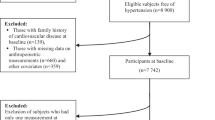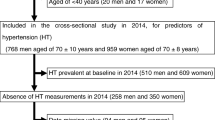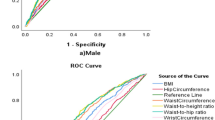Abstract
Purpose
This study proposes to examine the accuracy of four anthropometric indexes of obesity to identify the presence of hypertension and assess differences in the estimation and strength of effect measures of the association between each anthropometric measure and hypertension in Brazilian adults.
Methods
A population-based cross-sectional study was carried out with a sample of 1,720 adults from Florianópolis, Brazil. Receiver operating characteristic (ROC) curves were performed to identify the sensitivity and specificity of the best cutoff values for anthropometric indexes (body mass index—BMI, waist circumference—WC, waist-to height ratio—WHtR and conicity index—C-index) for prediction of hypertension. The associations between anthropometric indexes and hypertension were analyzed by Poisson regression expressed as Prevalence Ratios (95% CI) adjusted for socio-demographic variables, health behavior, height, and anthropometric indexes.
Results
Of the four anthropometric indexes studied, BMI, WC, and WHtR were found to have the largest areas under the ROC curve relative to hypertension in both sexes. The cutoff values in women and men associated with presence of hypertension were BMI of 24.9 and 24.6 kg/m², WC of 86.2 and 89.5 cm, WHtR of 0.49 and 0.50, and C-index of 1.15 and 1.18, respectively. WC and BMI had greater magnitude of association with presence of hypertension, adjusting for socio-demographic variables, health behavior, height, and anthropometric indexes in women and men, respectively.
Conclusions
Anthropometric indexes provide an effective, simple, inexpensive, and non-invasive means for a first-level screening for hypertension.

Similar content being viewed by others
References
Tuck ML, Corry DB (2010) Prevalence of obesity, hypertension, diabetes, and metabolic syndrome and its cardiovascular complications. Curr Hypertens Rev 6:73–82
Finucane MM, Stevens GA, Cowan MJ, Danaei G, Lin JK, Paciorek CJ, Singh GM, Gutierrez HR, Lu Y, Bahalim AN, Farzadfar F, Riley LM, Ezzati M, Global Burden of Metabolic Risk Factors of Chronic Diseases Collaborating Group (Body Mass Index) (2011) National, regional, and global trends in body-mass index since 1980: systematic analysis of health examination surveys and epidemiological studies with 960 country-years and 9.1 million participants. Lancet 377:557–567
National Institutes of Health, National Heart, Lung, and Blood Institute, (1998) Clinical guidelines on the identification, evaluation, and treatment of overweight and obesity in adults: the evidence report. Obes Res 6:S51–S210
Lee CM, Huxley RR, Wildman RP, Woodward M (2008) Indices of abdominal obesity are better discriminators of cardiovascular risk factors than BMI: a meta-analysis. J Clin Epidemiol 61:646–653
Wang TD, Goto S, Bhatt DL, Steg PG, Chan JC, Richard AJ, Liau CS, REACH Registry Investigators (2010) Ethnic differences in the relationships of anthropometric measures to metabolic risk factors in Asian patients at risk of atherothrombosis: results from the REduction of Atherothrombosis for Continued Health (REACH) Registry. Metabolism 59:400–408
Cox BD, Whichelow M (1996) Ratio of waist circumference to height is better predictor of death than body mass index. BMJ 313:1487
Mirmiran P, Esmaillzadeh A, Azizi F (2004) Detection of cardiovascular risk factors by anthropometric measures in Tehranian adults: receiver operating characteristic (ROC) curve analysis. Eur J Clin Nutr 58:1110–1118
Ho SY, Lam TH, Janus ED (2003) Waist to stature ratio is more strongly associated with cardiovascular risk factors than other simple anthropometric indices. Ann Epidemiol 13:683–691
Pitanga FJG, Lessa I (2005) Anthropometric indexes of obesity as an instrument of screening for high coronary risk in adults in the city of Salvador—Bahia. Arq Bras Cardiol 85:26–31
Brazilian Institute of Geography and Statistics (2009) Estimates of the resident population on 1 July 2009, according to cities. http://www.ibge.gov.br/home/estatistica/populacao/estimativa2009/POP2009_DOU.pdf. Accessed March 2010
Chobanian AV, Bakris GL, Black HR, Cushman WC, Green LA, Izzo JL Jr, Jones DW, Materson BJ, Oparil S, Wright JT Jr, Roccella EJ, National Heart, Lung, and Blood Institute Joint National Committee on Prevention, Detection, Evaluation, and Treatment of High Blood Pressure; National High Blood Pressure Education Program Coordinating Committee (2011) The seventh report of the joint national committee on prevention, detection, evaluation, and treatment of high blood pressure: the JNC 7 report. JAMA 289:2560–2572
Sociedade Brasileira de Hipertensão, Sociedade Brasileira de Cardiologia e Sociedade Brasileira de Nefrologia (2007) V Diretrizes Brasileiras de Hipertensão Arterial. Sociedade Brasileira de Hipertensão, Sociedade Brasileira de Cardiologia e Sociedade Brasileira de Nefrologia. Arq Bras Cardiol 89:e24–e79
Lohman TG, Roche AF, Martorell R (1998) Anthropometric standardization reference manual. Human Kinetics Books, USA, Champaign
Valdez R (1991) A simple model-based index of abdominal adiposity. J Clin Epidemiol 44:955–956
Gore C, Norton K, Olds T, Whittingham N, Birchall K, Clough M, Dickerson B, Downie L (1996) Accreditation in anthropometry: an Australian model. In: Norton K, Olds T (eds) Anthropometrica. University of New South Wales Press, Sydney, pp 395–411
Babor TF, Higgins-Bible JC, Saunders JB, Monteiro MG (2001) The alcohol use disorders identification test: guidelines for use in primary care, 2nd edn. World Health Organization, Geneve
Florindo AA, Hallal PC, Moura EC, Malta DC (2009) Practice of physical activities and associated factors in adults, Brazil, 2006. Rev Saúde Pública 43:65–73
Jaime PC, Figueiredo IC, Moura EC, Malta DC (2009) Factors associated with fruit and vegetable consumption in Brazil, 2006. Rev Saúde Pública 43:S57–S64
Swets JA (1973) The relative operating characteristics in psychology. Science 182:990–1000
Hanley JA, McNeil BJ (1982) The meaning and use of the area under a receiver operating characteristic (ROC) curve. Radiology 143:29–36
DeLong ER, DeLong DM, Clarke-Pearson DL (1988) Comparing the areas under two or more correlated receiver operating characteristic curves: a nonparametric approach. Biometrics 44:837–845
Danaei G, Finucane MM, Lin JK, Singh GM, Paciorek CJ, Cowan MJ, Farzadfar F, Stevens GA, Lim SS, Riley LM, Ezzati M, Global Burden of Metabolic Risk Factors of Chronic Diseases Collaborating Group (Blood Pressure) (2011) National, regional, and global trends in systolic blood pressure since 1980: systematic analysis of health examination surveys and epidemiological studies with 786 country-years and 5.4 million participants. Lancet 377:568–577
Almeida RT, Almeida MM, Araújo TM (2009) Abdominal obesity and cardiovascular risk: performance of anthropometric indexes in women. Arq Bras Cardiol 92:345–350
World Health Organization (2000) Obesity: preventing and managing the global epidemic. Report of a WHO consultation. World Health Organ Tech Rep Ser 894:i–xii, 1–253
Berber A, Gómez-Santos R, Fanghänel G, Sánchez-Reyes L (2001) Anthropometric indexes in the prediction of type 2 diabetes mellitus, hypertension and dyslipidaemia in a Mexican population. Int J Obes Relat Metab Disord 25:1794–1799
World Health Organization (2000) The Asia-Pacific perspective: redefining obesity and its treatment. WHO, Geneva
Pitanga FJ, Lessa I (2006) Waist-to-height ratio as a coronary risk predictor among adults. Rev Assoc Med Bras 52:157–161
Coniglio RI, Colombo O, Vasquez L, Salgueiro AM, Otero JC, Malaspina MM (1997) Central obesity: relationship between conicity index and lipoproteic parameters as a risk factors for coronary atherosclerosis. Medicina (B.Aires) 57:21–28
Lin WY, Lee LT, Chen CY, Lo H, Hsia HH, Liu IL, Lin RS, Shau WY, Huang KC (2002) Optimal cut-off values for obesity: using simple anthropometric indices to predict cardiovascular risk factors in Taiwan. Int J Obes Relat Metab Disord 26:1232–1238
Mansour AA, Al-Jazairi MI (2007) Cut-off values for anthropometric variables that confer increased risk of type 2 diabetes mellitus and hypertension in Iraq. Arch Med Res 38:253–258
Schneider HJ, Glaesmer H, Klotsche J, Böhler S, Lehnert H, Zeiher AM, März W, Pittrow D, Stalla GK, Wittchen HU, DETECT Study Group (2007) Accuracy of anthropometric indicators of obesity to predict cardiovascular risk. J Clin Endocrinol Metab 92:589–594
Wang TD, Goto S, Bhatt DL, Steg PG, Chan JC, Richard AJ, Liau CS, REACH Registry Investigators (2010) Ethnic differences in the relationships between anthropometric measures and metabolic risk factors in Asian patients at risk of atherothrombosis: results from the REduction of Atherothrombosis for Continued Health (REACH) Registry. Metabolism 59:400–408
Barbosa LS, Scala LCN, Ferreira MG (2009) Association between anthropometric markers of body adiposity and hypertension in an adult population of Cuiabá, Mato Grosso. Rev Bras Epidemiol 12:237–247
Yusuf S, Hawken S, Ounpuu S, Bautista L, Franzosi MG, Commerford P, Lang CC, Rumboldt Z, Onen CL, Lisheng L, Tanomsup S, Wangai P Jr, Razak F, Sharma AM, Sharma AM, Anand SS, INTERHEART Study Investigators (2005) Obesity and the risk of myocardial infarction in 27,000 participants from 52 countries: a case-control study. Lancet 366:1640–1649
Acknowledgments
We would like to thank Dr. Nilza Nunes da Silva, School of Public Health of the University of São Paulo, São Paulo, Brazil, for her advice on sample procedures and to the Brazilian Institute of Geography and Statistics (IBGE) and the Florianópolis Health Authority staff for their useful help with the practical aspects of the study.
Conflict of interest
The authors declare no conflict of interest. The Project was sponsored by the Brazilian National Council for Scientific and Technological Development (CNPq), grant number 485327/2007-4. ELP, and MAP received grants for research productivity (CNPq).
Author information
Authors and Affiliations
Corresponding author
Rights and permissions
About this article
Cite this article
Silva, D.A.S., Petroski, E.L. & Peres, M.A. Accuracy and measures of association of anthropometric indexes of obesity to identify the presence of hypertension in adults: a population-based study in Southern Brazil. Eur J Nutr 52, 237–246 (2013). https://doi.org/10.1007/s00394-012-0314-8
Received:
Accepted:
Published:
Issue Date:
DOI: https://doi.org/10.1007/s00394-012-0314-8




